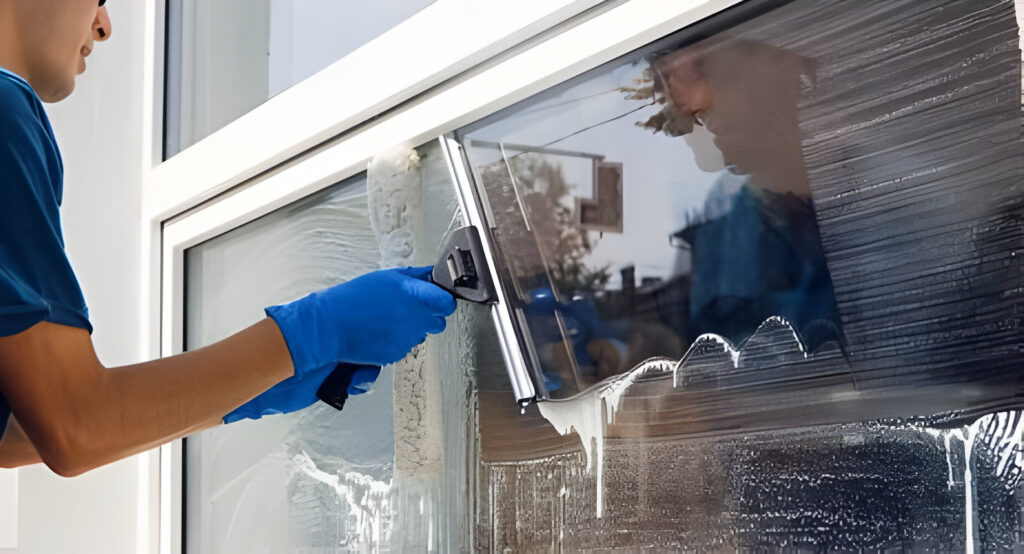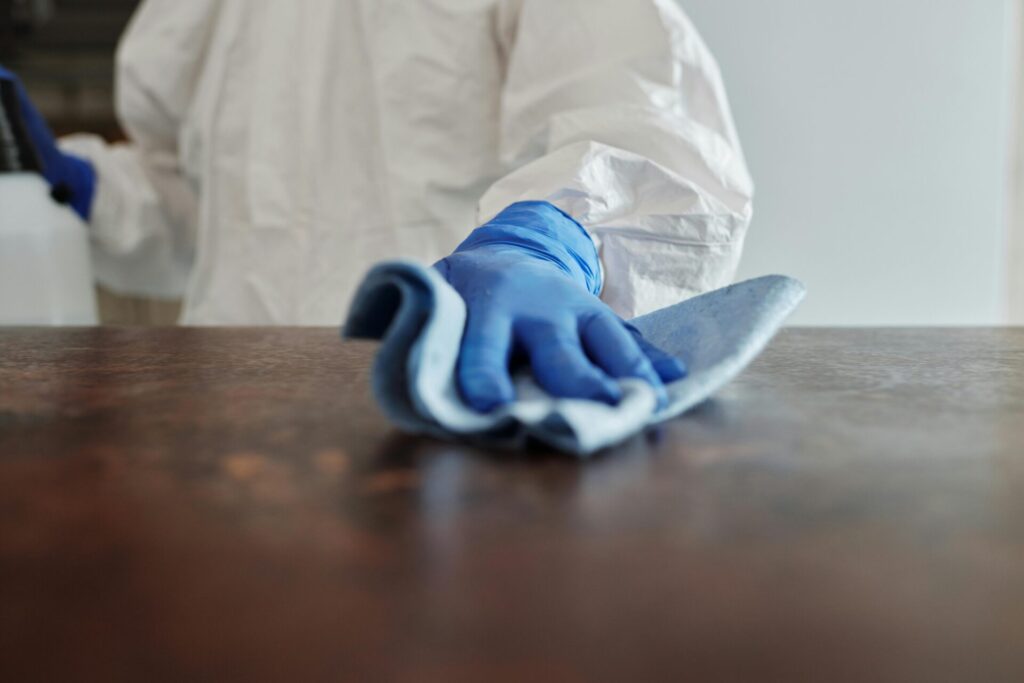When you’re ready to move out, end of lease cleaning becomes a critical task that can’t be overlooked. Also known as vacate cleaning or bond cleaning, it’s the process of thoroughly scrubbing and polishing every nook and cranny of your rented property. Why is this so crucial? It ensures you leave the property in pristine condition, which is often a requirement to get your full security deposit back. This rigorous cleaning goes beyond the regular weekly touch-up; it’s about deep-cleaning every surface and space to match the property’s initial state.
In the following sections, you’ll discover not just why end of lease cleaning is indispensable but also how to master it with ease. Expect to unveil a blend of professional insights and astonishingly simple hacks that can transform this daunting task into an achievable mission. Whether it’s dealing with lime-scaled faucets or grease-laden ovens, by the end of this article, you’ll be equipped with strategies to conquer even the most stubborn cleaning challenges and ensure your transition from tenant to mover is as seamless as possible.
Understanding End of Lease Cleaning
End of lease cleaning, also known as bond or vacate cleaning, is a comprehensive and meticulous process that aims to restore your rental property to its original condition before you, as the tenant, move out. This type of cleaning typically covers every nook and corner, from floor to ceiling, including areas like floors, walls, carpets, appliances, windows, cupboards, and outdoor spaces. It’s an essential step in the moving process that goes beyond regular house cleaning.

The necessity of carrying out a thorough end of lease clean can’t be understated. Not only does it ensure you leave behind a clean and hygienic environment for the next tenant, but it also plays a significant role in maintaining good relations with your landlord.
Most importantly though, end of lease cleaning is crucial in securing the return of your security deposit. When you first move into a rental property, you pay a security deposit meant to cover any potential damages or required cleaning after you move out. Landlords usually inspect the property at the end of your tenancy to assess its condition – if they find it satisfactory and up to the agreed-upon standards, they will refund your deposit in full.
By thoroughly cleaning your rental property before moving out:
- You demonstrate respect towards your landlord and the next tenant,
- You enhance your chances of receiving positive references for future rentals,
- And most significantly, you increase the likelihood of getting back your security deposit in full.
In essence, end of lease cleaning is a crucial part of the moving-out process that benefits both tenants and landlords alike.
The End-of-Tenancy Cleaning Checklist
Adhering to a comprehensive end-of-tenancy cleaning checklist ensures that every nook and cranny of your rental property is addressed before you move out. A meticulous room-by-room cleanup is critical for leaving the property in top condition and securing the return of your security deposit.
Kitchen:
The kitchen often accumulates the most grime and requires special attention during end of lease cleaning. Here are detailed tasks to focus on:
- Appliance Degreasing: Wipe down and degrease the oven, stovetop, microwave, refrigerator, dishwasher, and range hood. Remember to clean behind and underneath where possible.
- Cabinet Wiping: Empty all cabinets and drawers, wiping inside and out. Don’t forget the handles and knobs.
- Countertops & Surfaces: Disinfect countertops, backsplashes, and any other surfaces.
- Sinks & Taps: Remove limescale buildup around the sink and polish taps to a shine.
- Floors: Sweep and mop thoroughly, ensuring no food particles or stains remain.
Bathroom:
Bathrooms require thorough sanitization to remove any mold, soap scum, or water stains. Essential areas include:
- Toilet: Clean inside and out; pay special attention to the base and behind the toilet where dust gathers.
- Shower/Bathtub: Scrub tiles, shower screens, and grout lines; remove any mildew.
- Sink & Counters: Clean the basin thoroughly; wipe down counters and fixtures.
- Mirrors & Glass: Leave mirrors streak-free; clean any glass surfaces.
- Floors & Walls: Mop floors; also wipe down walls if there are visible splashes or soap stains.
Bedrooms and Living Areas:
These spaces should be inviting and clean for the next occupants. Specific requirements include:
- Carpet Vacuuming: Move furniture where possible to vacuum entire carpeted areas.
- Dusting of Furniture: Wipe down all surfaces including tables, chairs, dressers, window sills, and skirting boards.
- Window Cleaning: Clean windows inside (and outside if accessible), remove cobwebs, ensure curtains or blinds are dust-free.
- Light Fixtures & Fittings: Dust off light fixtures; replace any non-working bulbs.
In addition to these room-specific tasks, you must also address any tenancy-caused damage during the cleaning process. This includes patching up holes in walls from hanging pictures or artwork, fixing broken fixtures, or touching up paint where necessary. Ensuring these repairs are made can be just as important as cleaning for getting your full deposit back.
By following these room-by-room cleanup guidelines diligently, you set yourself up for a successful end of lease inspection. Remember that while cleaning takes effort and attention to detail, it is a crucial step in fulfilling your tenancy obligations.

Hiring Professional End of Lease Cleaners vs. DIY
The choice between hiring professional end of lease cleaners and doing it yourself can depend on several factors. Let’s take a closer look at the advantages and disadvantages of each option to help you decide which route to take.
Professional End of Lease Cleaners: Pros and Cons
Hiring professionals comes with a range of advantages:
- Expertise: Professional cleaners have the skills, experience, and knowledge to do a thorough and efficient job. They know the best methods to deal with tough stains or hidden dirt, making sure every part of your property is clean.
- Time-saving: Hiring professional cleaners saves you time and energy, allowing you to focus on other tasks related to your move.
- Peace of Mind: These services often include a guarantee that if your landlord isn’t satisfied with the cleaning, the professionals will come back and fix any issues for free.
However, there are also downsides:
- Cost: Hiring professionals can be expensive. The price usually depends on the size and condition of your property but can still be a significant expense.
Most professional end of lease cleaning packages include:
- Kitchen Cleaning: Degreasing appliances, wiping cabinets inside and out, cleaning sinks and countertops.
- Bathroom Restoration: Descale shower screens, scrub tiles and grout, sanitize toilet.
- Carpet Steam Cleaning: Deep clean carpets to remove dirt, stains, and allergens.
- General Cleaning: Dusting, vacuuming, mopping floors in all rooms.
DIY Cleaning: Tips for Success
If you’re thinking about doing the end of lease cleaning yourself to save money or because you enjoy it, here are some strategies to help you succeed:
- Plan ahead: Start early to avoid last-minute stress. Create a schedule that allows enough time for each task.
- Follow a checklist: Use an end-of-tenancy cleaning checklist to make sure you don’t miss any areas.
- Use the right tools: Invest in good-quality cleaning products and tools. They can make a big difference in how well your clean turns out.
- Be thorough: Pay attention to areas that are often overlooked, like inside cupboards, oven interiors, or behind appliances.
In summary, whether you should hire professionals or do it yourself depends on your budget, time constraints, and personal preferences. Both options have their pros and cons, so it’s important to weigh them carefully before making a decision.
No matter which route you choose, aiming for a thorough end of lease clean will make your move smoother and increase the likelihood of getting your bond back in full.
Surprising End of Lease Cleaning Hacks
Embarking on an end of lease cleaning journey can seem overwhelming, especially when you’re faced with seemingly stubborn stains or dust-laden corners. Fret not, as there exist creative ways to tackle common cleaning challenges during the end of lease process. Let’s dive into some unique and effective hacks that can come in handy for a successful and efficient end of lease clean.
Using Household Items as Cleaning Agents
For those challenging areas like hard water stains on shower heads or faucets, your kitchen pantry might hold the solution.
- Vinegar: This common item is a secret weapon against hard water stains. Soak a cloth in vinegar and wrap it around the stained area for an hour. After removing the cloth, scrub lightly with a toothbrush and rinse to reveal a sparkling clean surface.
- Baking Soda: When paired with vinegar, baking soda can be an excellent cleaning agent for stubborn kitchen grease or oven grime. Apply a paste of baking soda and water to the dirty area, let it sit for 15 minutes, then spray vinegar over it. The resulting chemical reaction helps lift off the stubborn grease, making it easier to wipe clean.
Efficiency in Cleaning Process
Efficiency is key when dealing with extensive cleaning tasks such as end-of-lease cleaning. Here are a couple of tricks to make your cleaning process more efficient:
- Top-to-Bottom Approach: Always start from the highest point in any room and work your way down. This ensures that dust or debris falling from high places won’t soil already cleaned areas.
- Room-by-Room Method: Tackling one room at a time helps avoid confusion and keeps you organized. Once one room is spotless and shining, move onto the next one.
Smart Use of Tools
Lastly, don’t underestimate the power of using the right tools effectively:
- Microfiber Cloths: These are not only environmentally friendly but also trap dust particles effectively compared to regular cloths.
- Toothbrush: An old toothbrush can be a handy tool for cleaning tight corners, grout lines, or intricate designs where typical cleaning tools might not reach.
Bear in mind that these surprising hacks aim to ease your end-of-lease cleaning process. While some tasks may still require professional attention, these tips will help you tackle common challenges confidently and efficiently.
The Importance of a Smooth Final Inspection
The final inspection by the landlord is a critical part of the end-of-lease process. It serves two main purposes:
- Assessing the condition of the property to ensure it has been left in a satisfactory state.
- Determining whether any deductions need to be made from the tenant’s security deposit for damages or repairs.
These two aspects are closely connected, as the results of the inspection will directly impact the return of the security deposit.
Why is the Final Inspection Important?
The final inspection is important for both landlords and tenants:
- For Landlords: It allows them to identify any issues or damages caused by the tenant during their occupancy. This helps in determining whether any deductions should be made from the security deposit to cover repair costs.
- For Tenants: It provides an opportunity to rectify any issues before moving out completely. By addressing these concerns, tenants can increase their chances of receiving a full refund of their security deposit.
Understanding Property Condition Assessments
During the final inspection, the landlord or property manager will carefully assess various aspects of the rental unit. Here’s what they will typically look for:
- Cleanliness: They will check if the different areas of the property (kitchen, bathroom, bedrooms, living areas) have been cleaned properly.
- Damages: They will inspect for any damages beyond normal wear and tear, such as broken fixtures, holes in walls, or stained carpets.
- Repairs: They will identify any repairs that are necessary due to actions taken by the tenant, like fixing a broken cabinet or replacing a damaged door.
- Belongings and Waste: They will ensure that all personal belongings and trash have been removed from the premises.
It’s essential for tenants to understand that their security deposit return is heavily dependent on these assessments. Maintaining a clean and damage-free rental unit is crucial throughout the lease term.
How the Security Deposit Return is Determined
Based on the findings of the final inspection, the landlord will make a decision regarding the return of the security deposit. Here’s how it typically works:
- Full Refund: If the property is in excellent condition with no damages or cleaning required, the tenant will receive a full refund of their security deposit.
- Partial Refund: If there are minor issues that need attention or repair costs due to damages, deductions may be made from the security deposit. For example, if there are stubborn stains on carpets despite the tenant’s cleaning efforts or if there is damage to walls that requires professional repair.
- No Refund: In some cases where significant damages have occurred or if the property is left in an unsatisfactory state, the landlord may withhold the entire security deposit.
Knowing Your Rights as a Tenant
As a tenant, it’s important to be aware of your rights during the final inspection process. This can help protect you from any unfair practices and ensure a smooth transition at the end of your lease. Here are key points you should know:
- Notification: Landlords should inform you about any issues identified during their final inspection within a reasonable time frame.
- Opportunity for Rectification: There should be an agreed-upon period (as mentioned in your lease agreement) during which you can address these issues without facing additional charges.
- Photographic Evidence: In some jurisdictions, landlords are required to provide photographic evidence of any damages they are claiming against your security deposit. This serves as a way to ensure transparency and prevent false claims.
By understanding these aspects of the final inspection process, you can better navigate the end-of-lease journey. Your knowledge of tenant’s rights and property condition assessments will play a crucial role in securing the return of your security deposit.
Conclusion
End of lease cleaning is an important part of moving out, making sure that you leave your rented place in perfect condition. By doing a thorough and careful clean, you not only fulfill your obligations but also increase the chances of getting your security deposit back in full without any disagreements.
- Recognize its importance: Understand the significance of end of lease cleaning and see it as a chance to think about your time as a tenant, showing respect and care for the property.
- Use effective methods: Try out the surprising cleaning tricks and proven strategies we’ve shared in this article. These techniques are designed to tackle even the toughest problems, from stubborn stains to making sure every corner is covered.
- Achieve outstanding results: Strive for excellence when cleaning. Whether you choose to do it yourself or hire professionals, aim for a level of cleanliness that matches or surpasses the condition recorded at the beginning of your lease.
Remember, a spotless end of lease clean not only protects your financial interests but also leaves a positive impression on your landlord, which could be helpful for future rental applications. With these tips and tricks, you’re ready to take on end of lease cleaning confidently and successfully.
FAQs (Frequently Asked Questions)
What is end of lease cleaning?
End of lease cleaning, also known as vacate cleaning or bond cleaning, refers to the thorough cleaning of a rental property before the tenant moves out. It is essential to ensure the property is left in impeccable condition for the next occupants.
Why is it necessary for tenants to clean the rental property before moving out?
Tenants are required to clean the rental property before moving out to fulfill their responsibilities outlined in the lease agreement. Failing to do so may result in deductions from the security deposit or other penalties.
What is included in the end-of-tenancy cleaning checklist?
The end-of-tenancy cleaning checklist includes room-by-room cleanup guidelines and addresses specific areas such as the kitchen, bathroom, bedrooms, living areas, and any tenancy-caused damage. Following this comprehensive checklist is crucial to ensure a smooth transition for tenants.
What are the advantages of hiring professional end of lease cleaners?
Hiring professional end of lease cleaners offers various advantages such as expertise, time-saving, and comprehensive services including kitchen cleaning, bathroom restoration, carpet steam cleaning, and more. However, tenants can also opt for a cost-saving DIY approach with practical tips and recommended products/tools for a successful job.
What are some surprising end of lease cleaning hacks?
There are unique and effective hacks for tackling common challenges encountered during end of lease cleaning, such as using vinegar for hard water stains. Additionally, practical tips and tricks can make the cleaning process more efficient and thorough.
How does the final inspection impact the security deposit return decision?
The final inspection assesses the property’s condition and significantly influences the decision regarding the return of the security deposit. It is important for tenants to understand their rights regarding a fair final inspection and any required rectifications within the specified notification period.

